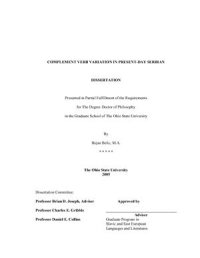
Ebook: Complement Verb Variation in Present-Day Serbian
Author: Belic Bojan.
- Genre: Linguistics // Foreign
- Tags: Языки и языкознание, Боснийский сербский хорватский черногорский, Грамматика
- Language: Serbian-English
- pdf
Publisher: The Ohio State University
Publication date: 2005
Number of pages: 247Strictly synchronically speaking, with verbs, nouns, and adjectives as heads of matrix clauses in a sentence, standard Serbian syntax allows for variation between a non-finite complement – that is, a complement headed by a verb not inflected for tense, grammatical person and number – and a finite complement – that is, a complement headed by a verb inflected for tense, grammatical person and number.
The non-finite complement is exclusively headed by an infinitive, a non-finite verb form in Serbian, whereas the finite complement is headed by a present tense form, a finite verb form in Serbian, invariably introduced by a complementizer da ‘that’ and, at the same time, in full grammatical agreement in person and number with the matrix. The variation of the two complements, referred to here as complement variation in Serbian (CVS), is a wellknown and a long-documented syntactic phenomenon, though never fully explained, at
least not in syntactic terms.
In this study I offer a critical view of the previous scholarship about the phenomenon, after which I provide a novel account of CVS. I view the phenomenon from the position of the latest views of control, more specifically unique control as a general
linguistic phenomenon.
Publication date: 2005
Number of pages: 247Strictly synchronically speaking, with verbs, nouns, and adjectives as heads of matrix clauses in a sentence, standard Serbian syntax allows for variation between a non-finite complement – that is, a complement headed by a verb not inflected for tense, grammatical person and number – and a finite complement – that is, a complement headed by a verb inflected for tense, grammatical person and number.
The non-finite complement is exclusively headed by an infinitive, a non-finite verb form in Serbian, whereas the finite complement is headed by a present tense form, a finite verb form in Serbian, invariably introduced by a complementizer da ‘that’ and, at the same time, in full grammatical agreement in person and number with the matrix. The variation of the two complements, referred to here as complement variation in Serbian (CVS), is a wellknown and a long-documented syntactic phenomenon, though never fully explained, at
least not in syntactic terms.
In this study I offer a critical view of the previous scholarship about the phenomenon, after which I provide a novel account of CVS. I view the phenomenon from the position of the latest views of control, more specifically unique control as a general
linguistic phenomenon.
Download the book Complement Verb Variation in Present-Day Serbian for free or read online
Continue reading on any device:

Last viewed books
Related books
{related-news}
Comments (0)